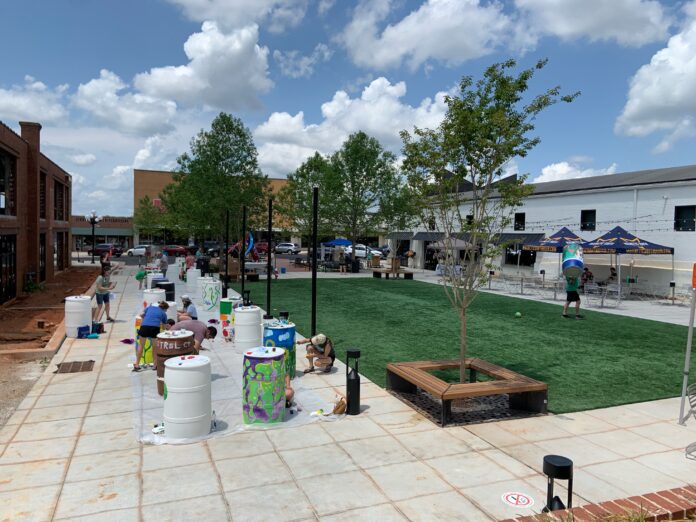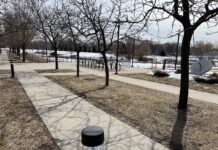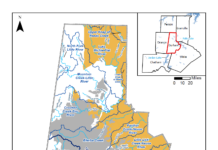
Sustainability Through Innovation
This article is part of Environmental Connection’s mission to help grow the industry by promoting innovative research, products and technology that meet industry needs through more sustainable approaches. Articles in future issues will continue to provide multiple perspectives to promote ongoing efforts to protect natural resources.
Since 1937, Soil and Water Conservation Districts have diligently worked to meet the needs of local landowners while also providing education and activities that help to advance resource conservation within the county, state and around the country. The South Carolina Conservation District Association represents the 46 Soil and Water Conservation Districts. These 46 districts make immeasurable impacts on the quality of land, water and related natural resources.
One district in Anderson County, South Carolina hosts an annual event that draws people from around the state to participate. Anderson Soil and Water Conservation District (ASWCD) is charged with meeting basic land, water and other natural resource problems locally. ASWCD is a subdivision of the South Carolina Department of Natural Resources. Each year ASWCD, in partnership with Anderson Regional Joint Water System (ARJWS), hosts an event called “Barrels and Beer” at local breweries in Anderson County. The 2023 Barrels and Beer event will be the event’s 5th anniversary.
The event provides environmental education and fun activities that teach community members how to become environmental stewards in their own backyards. Proceeds from the event are given back to the community through an Environmental Stewardship Mini-Grant program that awards up to $1,000 grants to people, businesses or schools to assist with projects related to protecting the environment, sustainable farming or environmental outreach and education.
To prepare for the event, 55-gallon (100-liter) rain barrels are donated to ASWCD each year from various businesses that have extra food grade barrels. The educational aspect of this event provides participants a unique viewpoint of how beers are brewed using locally sourced waters and the many different groups that work to protect these waters such as ARJWS, Lake Hartwell Partners for Clean Water, the Natural Resource Conservation Service, Clemson Extension, Upstate Forever, Savannah River Keeper and other groups.
One of the main attractions in Anderson County is its beautiful lakes, streams and waterways. Lake Hartwell can be seen while driving through the county and covers over 56,000 acres (22,662 hectares) and 962 miles (15,490 km) of shoreline stretching over South Carolina and Georgia. This lake provides the county with its drinking water and is one of the region’s largest man-made lakes. Participants at Barrels and Beer hear from expert guest speakers during educational sessions. As participants learn, they are also creating their own art masterpieces by painting their rain barrels (Figure 1) to make them more aesthetically pleasing. ASWCD believes that tying education, enjoyment and social together creates an atmosphere that helps to strengthen the bonds within the conservation family.
The 2018 Journal of Environmental Management states “…the effectiveness of urban stormwater management practices on local water quality is dependent on adoption rates reaching a critical mass.”1 Urban areas have seen an increase in impervious surfaces such as roads, rooftops and sidewalks that lead to more stormwater runoff, which means a higher chance for pollutants to enter waterways and increased flooding. Being mindful of these impacts directs us to think about the ways individuals can make a difference. Rainwater harvesting, or bioretention, is defined as the collection and storage of rainwater that runs off rooftops, parks, roads and open grounds.2 Rainwater harvesting allows homeowners to save water between rain events and prepare for times of drought.
Approximately 33 rain barrels are sold and installed at Anderson County households from ASWCD’s Barrels and Beer event each year. Based on the number of rain barrels sold each year and using the average home size in South Carolina, an estimate of the amount of rainfall collected by participants each year can be formed. The average roof size of a standard home is around 1,000 square feet (92.903 square meters). If a 1-inch storm generates 623 gallons (2.36 cubic meters) of runoff on an average size roof according to Clemson Carolina Clear’s “Rainwater Harvesting for Homeowners” manual, then an estimated 20,559 gallons (77.82 cubic meters) of stormwater is collected each year from event participants from a single 1-inch rainfall event.3
The impact that this event has on our community in Anderson County makes a huge difference for conservation. Not only does it spark interest in stormwater management and conservation practices, but it also gives back to the community through the Environmental Stewardship Mini-Grants to continue the legacy of locally led conservation efforts.
References:
- Gao Y, Church SP, Peel S, et al. Public Perception Towards River and Water Conservation Practices: Opportunities for Implementing Urban Stormwater Management Practices. Journal of Environmental Management. 2018. 223:478-488.
- Ibid.
- Giacalone K, Joyner D, Bishop M, et al. Rainwater Harvesting for Homeowners. Clemson University Carolina Clear. 2011.
About the Expert
Anaston Porter is the Anderson Soil and Water Conservation District Education and Outreach Coordinator.
By the Numbers: SC Conservation Districts’ Impact
The South Carolina Conservation District Association’s 46 Soil and Water Conservation Districts work throughout the year to promote environmental education and support conservation efforts. Highlights of the 2021 efforts include:
More than 20,000 adults educated on varying conservation topics including Farm Bill programs, pollinator promotion, stormwater mitigation, invasive species control, prescribed fire, water quality and conservation, habitat restoration and land easements.
Over 4,000 acres (1,600 hectares) statewide impacted by conservation rental equipment available through conservation districts (no-till drills, prescribed fire equipment, feral hog traps, etc.).
30,000 students were reached by conservation district youth oriented programs such as school gardening, seed libraries, SC Envirothon, Arbor Day and Earth Day events, stormwater education, scholarships, and conservation related contests in 2021.











